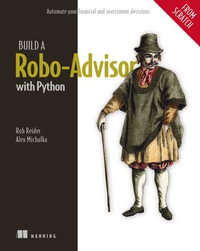
eTEXT
Mastering Geospatial Analysis with Python
Explore GIS processing and learn to work with GeoDjango, CARTOframes and MapboxGL-Jupyter
By: Silas Toms, Eric van Rees, Paul Crickard
eText | 27 April 2018 | Edition Number 1
At a Glance
eText
$67.09
OR
Free with Kobo Plus Read
Start Free Trial *- Subscribe and read all you want.
- $13.99 a month after free trial. Cancel Anytime. Learn more.
Instant online reading in your Booktopia eTextbook Library *
Read online on
Not downloadable to your eReader or an app
Why choose an eTextbook?
Instant Access *
Purchase and read your book immediately
Read Aloud
Listen and follow along as Bookshelf reads to you
Study Tools
Built-in study tools like highlights and more
* eTextbooks are not downloadable to your eReader or an app and can be accessed via web browsers only. You must be connected to the internet and have no technical issues with your device or browser that could prevent the eTextbook from operating.
Explore GIS processing and learn to work with various tools and libraries in Python.
About This Book
- Analyze and process geospatial data using Python libraries such as; Anaconda, GeoPandas
- Leverage new ArcGIS API to process geospatial data for the cloud.
- Explore various Python geospatial web and machine learning frameworks.
Who This Book Is For
The audience for this book includes students, developers, and geospatial professionals who need a reference book that covers GIS data management, analysis, and automation techniques with code libraries built in Python 3.
What You Will Learn
- Manage code libraries and abstract geospatial analysis techniques using Python 3.
- Explore popular code libraries that perform specific tasks for geospatial analysis.
- Utilize code libraries for data conversion, data management, web maps, and REST API creation.
- Learn techniques related to processing geospatial data in the cloud.
- Leverage features of Python 3 with geospatial databases such as PostGIS, SQL Server, and SpatiaLite.
In Detail
Python comes with a host of open source libraries and tools that help you work on professional geoprocessing tasks without investing in expensive tools. This book will introduce Python developers, both new and experienced, to a variety of new code libraries that have been developed to perform geospatial analysis, statistical analysis, and data management. This book will use examples and code snippets that will help explain how Python 3 differs from Python 2, and how these new code libraries can be used to solve age-old problems in geospatial analysis.
You will begin by understanding what geoprocessing is and explore the tools and libraries that Python 3 offers. You will then learn to use Python code libraries to read and write geospatial data. You will then learn to perform geospatial queries within databases and learn PyQGIS to automate analysis within the QGIS mapping suite. Moving forward, you will explore the newly released ArcGIS API for Python and ArcGIS Online to perform geospatial analysis and create ArcGIS Online web maps. Further, you will deep dive into Python Geospatial web frameworks and learn to create a geospatial REST API.
Style and approach
The book takes a practical, example-driven approach to teach you GIS analysis and automation techniques with Python 3.
Read online on
ISBN: 9781788293815
ISBN-10: 1788293819
Published: 27th April 2018
Format: ePUB
Language: English
Publisher: Packt Publishing
Edition Number: 1
You Can Find This eBook In
This product is categorised by
- Non-FictionComputing & I.T.DatabasesData Capture & Analysis
- Non-FictionComputing & I.T.Graphical & Digital Media Applications3D Graphics & Modelling
- Non-FictionComputing & I.T.Computer Programming & Software DevelopmentProgramming & Scripting Languages
- Non-FictionComputing & I.T.DatabasesDatabase Design & Theory
- Non-FictionComputing & I.T.Computer ScienceHuman-Computer InteractionInformation Architecture
- Non-FictionComputing & I.T.Computer ScienceComputer Architecture & Logic Design























